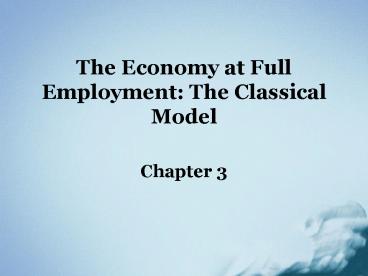The Economy at Full Employment: The Classical Model - PowerPoint PPT Presentation
1 / 20
Title:
The Economy at Full Employment: The Classical Model
Description:
A description of how households, firms, governments and ... Income effect: at low wage work more, but at very high wage work less. Thus ambiguous result. ... – PowerPoint PPT presentation
Number of Views:304
Avg rating:3.0/5.0
Title: The Economy at Full Employment: The Classical Model
1
The Economy at Full Employment The Classical
Model
- Chapter 3
2
Teaching Assistant
- Mashiur Rahman
- Office Hours T Th 100 pm to 130 pm
- Office 555 Fletcher Argue Building
3
Macroeconomic Model
- A description of how households, firms,
governments and foreigners take decisions and how
these decisions are coordinated in markets.
4
- Endogenous Variables
- Variables whose values are determined by the
model. - Exogenous Variables
- Variables whose values are determined outside
the model.
5
Classical Model
- A classical model is a macroeconomic model that
explains how Real GDP and other variables are
determined at full employment.
6
- A classical model have a long list of endogenous
variables. They are of two types. Real and
nominal. - Real Variables real GDP, savings, investment and
the real interest rate. - Nominal Variables price level and money wage
rate. - Exogenous Variables state of technology, govt.
expenditure, taxes and quantity of money.
7
The Canadian Economy at Full Employment
8
- It was very close at full employment in 1980,
1981, 1987, 1990 and 1999 - Rows 2-4 show the real GDP, employment and the
real wage rate at a full employment and all three
increase over time. - Investments increased over time.
- Real interest rate does not.
- Last three rows show the price level, inflation
rate and the interest rate. - Price level increases over time but opposite is
true for inflation and rate of interest
9
A Question to ask
- What determines the level of Real GDP,
employment, and the real wage rate, investments,
savings and the real interest rate, the price
level, inflation and nominal interest rate? - Objective is to determine the level of full
employment, the real wage rate and real GDP at
full employment (i.e. potential GDP)
10
Approach objectives in four steps
- The short run production function
- The demand for labor
- The supply of labor
- Labor market equilibrium.
11
The short run production function
- The relationship between the maximum attainable
real GDP and the quantity of labor. - Only labor is the variable input.
- Slope is the marginal product of labor.
12
The Short Run Production function and the demand
for labor
- Slopes upward. Increase in labor increases the
Real GDP. - Slope when employment is at 25 bn hrs is the
slope of the tangent (black line) at this
employment level. It is equal to the hypotenuse
of the triangle, 20 bn hrs.
13
The Demand for Labor
- Demand for labor can be derived from the short
run production function. - Relationship between the quantity of labor
employed and the real wage rate.
14
- A profit maximizing firm at which the cost of
last hour of labor employed brings in an equal
amount of revenue. - Employ labor till
- W(MP)P
- or, W/PMP i.e. marginal product is equal to the
real wage rate - The lower the real wage, greater the quantity of
labor employed.
15
Shifts in the Production Function and Demand for
Labor
- Capital accumulation and technological change
shift the production function upward. - At any level of output the MP of labor is now
higher. - Demand for labor increases.
16
Supply of Labor
- Work versus other activities The real wage rate
has two effects on the quantity of labor
supplied- income effect and a substitution
effect. - Substitution effect encourages to work more.
- Income effect at low wage work more, but at very
high wage work less. Thus ambiguous result. It
gives us backward bending supply curve.
17
- Work today versus work later
- Real interest rate plays a role.
- The opportunity cost of working today versus work
later need to be considered. - The labor supply curve
- The relationship between the quantity of labor
supplied and the real wage rate. - Its upward sloping
18
Changes in the Supply of Labor
- Changes in population influence naturally.
- Higher real interest rate, greater the tendency
to work today
19
Labor market equilibrium and Potential GDP
- Labor market equilibrium determines the real wage
and the level of employment. - If real wage exceeds the equilibrium, then excess
labor supply this brings wage down to its
equilibrium level. - If real wage is below equilibrium, then excess
demand and the real wage rate goes up to its
equilibrium level.
20
- At equilibrium, there is neither an excess supply
nor an excess demand. - Potential GDP short run production function
shows the relationship between real GDP and the
quantity of labor employed. At the labor market
equilibrium, employment is at its full employment
level. And the quantity of real GDP produced by
the full employment quantity of labor is
potential GDP.































